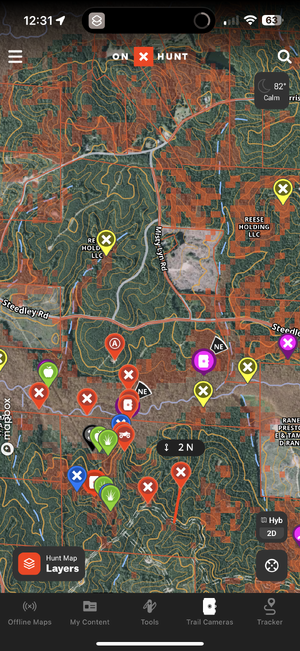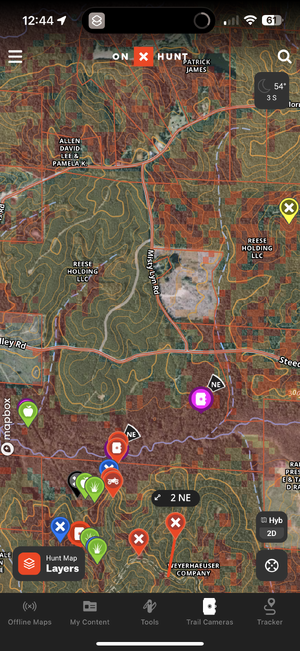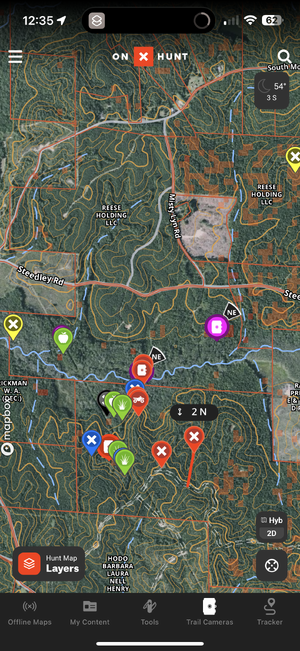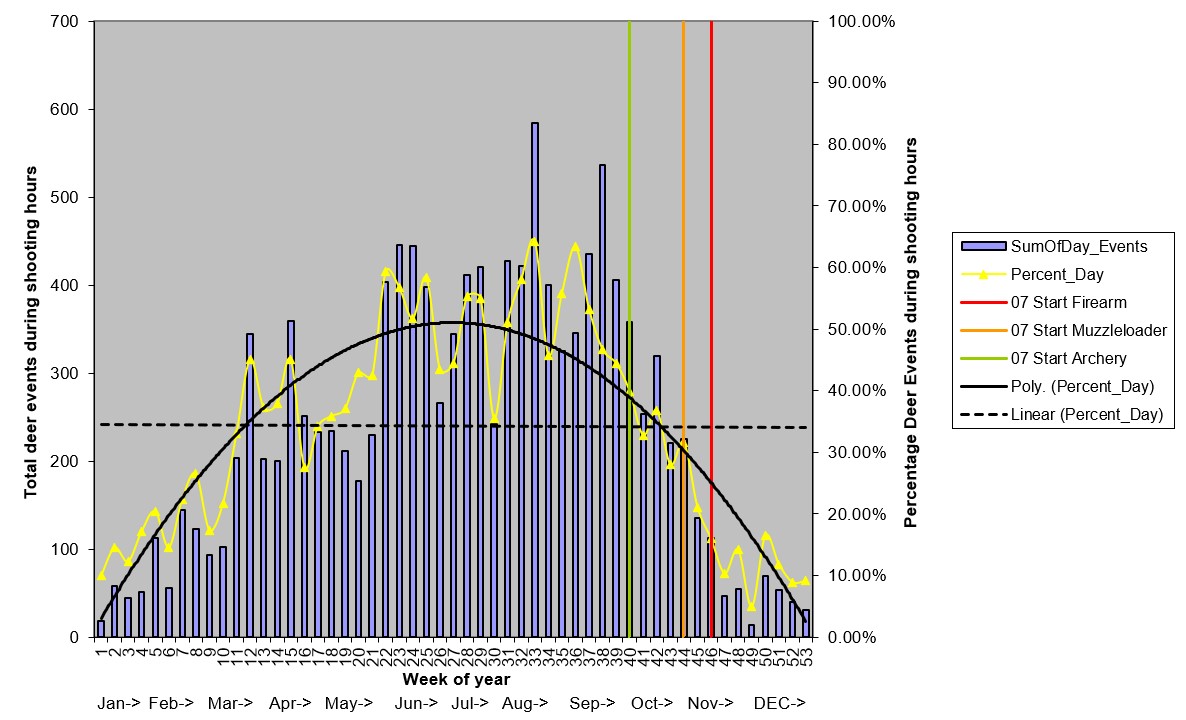I was hoping to get some more

 wisdom on hunting a nocturnal deer. If you look on the map that I have attached a picture of where the purple trail cam is marked. I am getting pictures of two mature and big bucks, but they are only coming out at night. This is a hunting club and the land that I am allowed to hunt is the Weyerhauser land and the Resse Holdings land. I am getting pictures of these deer over some corn that I have been putting out, and I have been watching some videos on hunting nocturnal deer. I have two other cameras out within a mile or mile and a half on other food sources and no pictures of those deer there. From what I know I probably need to find these deer bedding areas and try to locate them that way. Do any of you see anything on the map that you would consider a prime bedding area? I have also added a few more pictures one that shows more land, and another that has a filter on showing the deciduous vs coniferous tree distribution. Also, I feel it important to mention that you can see the trees change from deciduous in the area where the camera is. That area has recently been clear-cut about 4 years ago so it is covered in pine saplings and grass about 4 or 5 ft tall. Any information or insight is welcome.
wisdom on hunting a nocturnal deer. If you look on the map that I have attached a picture of where the purple trail cam is marked. I am getting pictures of two mature and big bucks, but they are only coming out at night. This is a hunting club and the land that I am allowed to hunt is the Weyerhauser land and the Resse Holdings land. I am getting pictures of these deer over some corn that I have been putting out, and I have been watching some videos on hunting nocturnal deer. I have two other cameras out within a mile or mile and a half on other food sources and no pictures of those deer there. From what I know I probably need to find these deer bedding areas and try to locate them that way. Do any of you see anything on the map that you would consider a prime bedding area? I have also added a few more pictures one that shows more land, and another that has a filter on showing the deciduous vs coniferous tree distribution. Also, I feel it important to mention that you can see the trees change from deciduous in the area where the camera is. That area has recently been clear-cut about 4 years ago so it is covered in pine saplings and grass about 4 or 5 ft tall. Any information or insight is welcome.


 wisdom on hunting a nocturnal deer. If you look on the map that I have attached a picture of where the purple trail cam is marked. I am getting pictures of two mature and big bucks, but they are only coming out at night. This is a hunting club and the land that I am allowed to hunt is the Weyerhauser land and the Resse Holdings land. I am getting pictures of these deer over some corn that I have been putting out, and I have been watching some videos on hunting nocturnal deer. I have two other cameras out within a mile or mile and a half on other food sources and no pictures of those deer there. From what I know I probably need to find these deer bedding areas and try to locate them that way. Do any of you see anything on the map that you would consider a prime bedding area? I have also added a few more pictures one that shows more land, and another that has a filter on showing the deciduous vs coniferous tree distribution. Also, I feel it important to mention that you can see the trees change from deciduous in the area where the camera is. That area has recently been clear-cut about 4 years ago so it is covered in pine saplings and grass about 4 or 5 ft tall. Any information or insight is welcome.
wisdom on hunting a nocturnal deer. If you look on the map that I have attached a picture of where the purple trail cam is marked. I am getting pictures of two mature and big bucks, but they are only coming out at night. This is a hunting club and the land that I am allowed to hunt is the Weyerhauser land and the Resse Holdings land. I am getting pictures of these deer over some corn that I have been putting out, and I have been watching some videos on hunting nocturnal deer. I have two other cameras out within a mile or mile and a half on other food sources and no pictures of those deer there. From what I know I probably need to find these deer bedding areas and try to locate them that way. Do any of you see anything on the map that you would consider a prime bedding area? I have also added a few more pictures one that shows more land, and another that has a filter on showing the deciduous vs coniferous tree distribution. Also, I feel it important to mention that you can see the trees change from deciduous in the area where the camera is. That area has recently been clear-cut about 4 years ago so it is covered in pine saplings and grass about 4 or 5 ft tall. Any information or insight is welcome.
